new posts in all blogs
Viewing: Blog Posts Tagged with: exercises, Most Recent at Top [Help]
Results 1 - 12 of 12
How to use this Page
You are viewing the most recent posts tagged with the words: exercises in the JacketFlap blog reader. What is a tag? Think of a tag as a keyword or category label. Tags can both help you find posts on JacketFlap.com as well as provide an easy way for you to "remember" and classify posts for later recall. Try adding a tag yourself by clicking "Add a tag" below a post's header. Scroll down through the list of Recent Posts in the left column and click on a post title that sounds interesting. You can view all posts from a specific blog by clicking the Blog name in the right column, or you can click a 'More Posts from this Blog' link in any individual post.
.jpeg?picon=3498)
By: Cait,
on 9/11/2014
Blog:
Cait's Write...
(
Login to Add to MyJacketFlap)
JacketFlap tags:
tips,
running,
shoes,
injuries,
training,
exercises,
strength training,
stretching,
ask me,
Add a tag
I always love getting mail from readers and I often get questions which, because I could talk/write/draw about running all day, I’m always happy to answer. The other awesome thing about bloggy-land and our cyber-culture is constantly making new friends. I enjoy hearing updates back from the runners I’ve ‘met’ after they’ve sent questions and it’s always cool to watch them go on to run healthy and set new PR’s.

Well because great minds think alike, or at least I’m certain questions I’m emailed are ones others probably have, I decided to share a few. If you’ve got a questions feel free to email me at: [email protected]
Without further adieu:
Q: Hi! Do you do your calf strengthening exercises before or after running or on days off? Just curious… I am 45 and returning after a 2 month hiatus. After a 14 day streak (7 @ 20 min and the 7 @ 30 min, my calfs are starting to get cranky)
Do you think everyday is good for us over 40 runners or should I be taking days off?
Thank you so much. Your pages are very helpful?
~ Dan in Portland, OR
A: Hi Dan! Thanks so much for your readership! First off, CONGRATS on finally getting back to running!!
As for your questions: I’d suggest doing the strengthening exercises every other day, but do lots of stretching every day. Always post-run on both of those, for the stretches do the standing wall stretch both standing with your leg straight and and then with a slight bend in the knee, that will work both calf muscles. Also do one with a heel drop, so stand on a stair and just let your heel drop, slowly working deep into that achilles stretch.
As for your running, every single person is different, so it’s a matter of figuring out your running ‘sweet spot’. For now, with being cautious for your cranky calfs, tailor back to 4-5 days and you can totally do some cross training that doesn’t bother it. Then as the calfs calm down, gradually try increasing total time running, be that either running longer OR with added days running. Aim for only increasing 10% total miles each week, then let those calfs be your guide.
Finally, don’t overlook that the body is a whole unit, so be sure to check out if you’ve got other imbalances that could be setting you up for calf pain, and stretch the whole body. Check your biomechanics and you might need some insoles for added support. Also, make sure you’re running in the right shoes and they’re not ‘dead’…you’d be surprised how ‘easy’ things like needing to replace your shoes can totally clear up your symptoms!
Hope that helps, sorry for the novel reply, and say HI to Portland for me…miss that awesome city!
Happy Running!!
Cait
—-
Related Reads:
The Imbalanced Runner: Pinpoint your weaknesses and avoid injuries
The Low Mileage Runner: How to maximize your performance off of low volume
3 Ways Running Can Fly By and 500 Reasons to Update Your Running Shoes

.jpeg?picon=3498)
By: Cait,
on 8/13/2014
Blog:
Cait's Write...
(
Login to Add to MyJacketFlap)
JacketFlap tags:
tips,
running,
motivation,
goals,
injuries,
training,
exercises,
stretching,
cross training,
training tips,
Add a tag
Being patient sucks. Waiting for what we want isn’t fun, but the reality is that often times we are forced to wait. Even more often is it that rushing things will ultimately leave us more frustrated in the long term.
As runners, wouldn’t it be awesome if we could just lace up and make our next race/workout/run a PR? If only, right?! The natural tendency to want those faster times and better fitness TODAY is the breeding ground for injuries, overtraining, and slowed progress. Beautiful irony there, right?

Every runner has been guilty of it, and hey, some things you just have to learn yourself the hard way. (Sometimes a few times to really NAIL that lesson home.) Being patient sucks…but we need to learn to embrace it.
Yikes. Where’s the spoonful of sugar to wash that down? Well that comes when you actually ARE patient and watch your goals materialize…eventually.
The sweetest victories only come after enough struggle and work, after all.
Convincing yourself to wait it out and be patient is tough and often an on-going battle. Incidentally a large part of being able to stay patient comes from confidence. How so?
Being patient means BELIEVING in yourself, what you’re doing, and the process. A runner who lacks confidence is the one who tends to rush things, an example of that is going out way too fast in a race. It takes MORE confidence and patience to go out controlled and then pick up the pace, and close fast. A runner who tries to ‘make a buffer’ by going out too fast is subconsciously affirming they are going to slow down. See how that’s not a good way to think? It takes more confidence to be patience, wait, and then respond to your competitors (or go faster) as the race progresses.
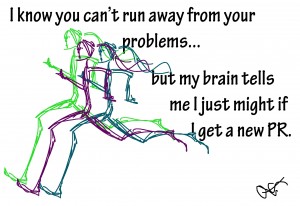
New runners can be a little less than confident in their abilities as they venture into a new sport. That’s natural, but it’s dangerous to go into information overload and want to do EVERYTHING and anything they read about training and incorporate it right away. This usually leaves them injured or too sore/tired that they lose any desire to continue running.
Even if you’ve been a runner for years and years, it’s quite easy to fall into the same trap of wanting to add in XYZ all at the same time…to rush the process. You know what, the same road leads to the same place.
Avoiding injuries and reaching your best takes time. Waiting is hard and it can suck at times, but if you try and rush things too fast it will, in the end, it will suck even more. (nightmares of time off or on the cross trainer missing your race should help keep you patient.  )
)
There really ARE tons of training elements to keep you improving and progressing through the years. This should be exciting news, it’s just imperative not to rush things.
I will say that the BEST way to stay patient and keep yourself honest on the right track (in the moment it can be REALLY hard sometimes to know you need to be patient) is to a have a coach. If not a coach then at least an educated source or training group to bounce things off of. Today it’s important to recognize the source of the training advice you’re getting and if it’s actually got merit.
Being patient can suck in the moment, but eventually it is oh so sweet.
—-
More posts on training tips HERE
Some of those ‘extra’ training elements to help you improve: CORE STRETCHING DRILLS
—-
1) How do you remind yourself to stay patient when you really don’t want to wait?
2) What keeps you honest/patient when it comes to your training?
3) When is an instance where NOT being patient made things much worse for you?

.jpeg?picon=3498)
By: Cait,
on 6/15/2014
Blog:
Cait's Write...
(
Login to Add to MyJacketFlap)
JacketFlap tags:
running,
motivation,
art,
drawing,
goals,
exercises,
races,
Sunday Morning Inspiration,
sunday morning motivation,
Add a tag
Moments before the gun. All other runners slip away, left one.
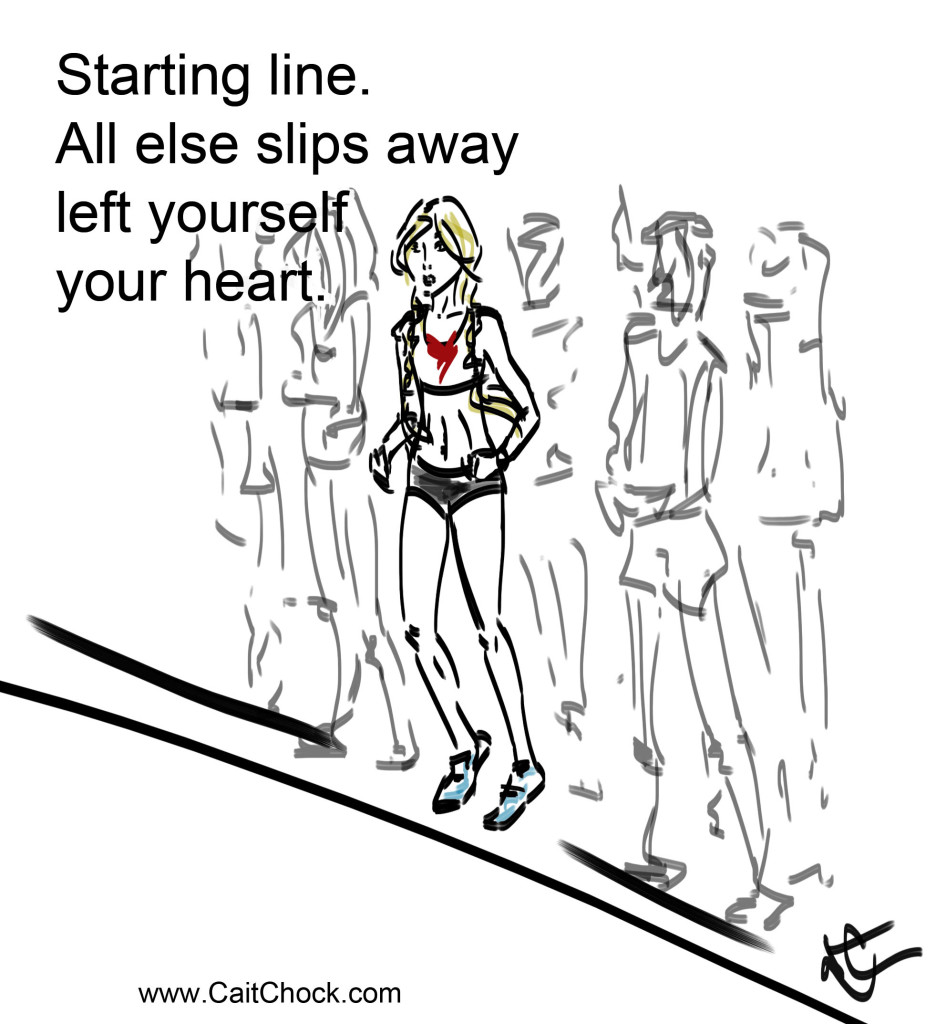
———
More posts on MOTIVATION
Another post on Starting Line Confidence and How to Build Yours
Talk about one cute chicker from the weekend!! This super fast runnerchick was the top female and 5th overall in just her first 5k!! Can you say natural born runnerchick?! At least her Ezzere Get Chicking Tee gave them a warning…keep on smoking those runnerboys. 

————-
1) What’s usually one of the last things you do RIGHT before the gun goes off?

.jpeg?picon=3498)
By: Cait,
on 5/24/2014
Blog:
Cait's Write...
(
Login to Add to MyJacketFlap)
JacketFlap tags:
tips,
running,
videos,
goals,
training,
track,
exercises,
races,
workouts,
race tips,
Add a tag
Everyone wants to run faster, right? Part of getting faster is of course doing the shorter repeats; one must build that explosive power of course. BUT, there’s another part to getting faster and it’s training your BRAIN and nervous system to respond at a quicker rate.
A runner can’t utilize that explosive power to run faster without the nerve and synapse networks first being created to ‘tell’ your foot to move faster off the ground. Isn’t science and the brain cool?
The neuromuscular part of training isn’t something every runner is aware of, but if you’re not addressing it you can run all the 200′s in the world and not really be tapping into your full potential. I’ve written a few articles about the neuromuscular training and how it relates to runners:
* The Multi-Level Approach to Getting Faster
* Work on Getting Faster in Tri-Fecta Form
One of the exercises I mention are ‘Quick Feet Box Taps’. I got an email from someone who wasn’t quite sure if they were doing them right so I decided to make a little video.
You can also find it on my Instagram page. Start with a set of 15-30 seconds and see how many taps you can get. REMEMBER it’s QUALITY over quantity. If you’re getting slopping you’re going to start reinforcing bad habits and that will defeat the purpose. Work up to two sets and do the 3 times a week…preferably as part of your dynamic warm-up routine before workouts or immediately following the workout. It can be fun to watch yourself improve with more taps every week…you know us runners and that competitive spirit.  But again, quality over quantity…so if you have to start slow that’s what you need to do!
But again, quality over quantity…so if you have to start slow that’s what you need to do!
What, you love my shirt too?! Well, thanks…it’s my Ezzere Runner Face Tee! 
Happy Saturday my runner friends. Get those feet firing off the ground, coupling neuromuscular training and speedwork, and watch your PR’s get faster! 

.jpeg?picon=3498)
By: Cait,
on 5/20/2014
Blog:
Cait's Write...
(
Login to Add to MyJacketFlap)
JacketFlap tags:
tips,
running,
Cartoons,
motivation,
goals,
training,
exercises,
stretching,
core,
Add a tag
Good things can come in threes, but then again plenty of awesome things come in twos and fours. Runners have two legs, four laps make that perfect mile…though do those four laps REALLY feel all that perfect when doing mile repeats??  Brain: “FOUR laps, let’s call a mile one lap!” Juuust kidding.
Brain: “FOUR laps, let’s call a mile one lap!” Juuust kidding.
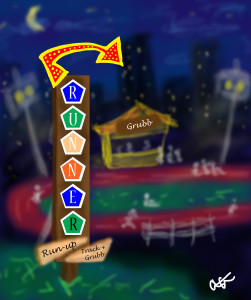
The cool place all runners get to hang out.
Well good things can come in any number but today you runners are getting a three-pack. Here are some Training Tips in Triple for your Tuesday:
1) Runners Who Skip: Runners can become a little too linear for their own good. Example is looking only at their running workouts to improve and taking that little metaphor to the literal: running is a repetitive, linear, single-plane action. If you don’t work your body in a variety of ways it gets tight. Tight will equal restrictive, bring you injuries and impede your speed.
Offset that by doing things OTHER than running: core work, flexibility, and agility drills. Move in the horizontal, even do some skipping to ‘dilly around’ with your neuromuscular thought patterns. Your brain actually has to be ‘played with’…it gets stuck in a pace/pattern run with just running. So as crazy as it sounds doing things like skipping, backwards skips, crazy feet drills give it a little ‘reset’ and make it more ‘sharp’ when you come back to running steps. Oh, and those fast feet, like chili pepper jump rope things, those will help your neuromuscular training too…get those feet conditioned to FIRE off the ground faster = faster speed and sprinting.
2) Be Quiet I’m Sleeping: Sleeping should really be an Olympic sports…or at least one of everyone’s favorite past times. Want to have a sleep-off? Just kidding. But seriously, for the runner in training you should guard your zzzz’s with just as much ferocity as you do lane one during repeats.

Sleep is where you body does the vast majority of its repair, sleep is a restorative process. But it’s really the deep, REM sleep that you need. That’s why people who are light sleepers or wake up multiple times in the night can still feel so flipping tired later even if they’ve been in bed 8-12 hours…they’re not sleeping continuously or getting a deep enough sleep. Sleep issues are really tricky, I’ve got them, so if you do have trouble sleeping already do the basics: make it as dark as possible, don’t even have the light from your phone on, try a fan for white noise, relax and power-down before bedtime to put your brain in sleep-mode, and from there you may need to seek out some other options and work with a doctor.
For those of you are are lucky enough to NOT have a problem sleeping but just skimp on the hours because you’re busy, I’ll say this: 1) you’re only hurting yourself and your training 2) you’re taking sleeping for granted…trust me, lots of us insomniacs would die to get some extra hours!! haha…take advantage of them and aim for 8-9 hours a night for optimal performance.
3) Laugh: Wow…you think I’m a nutzo for just saying that. I’ll go on record and rattle off just why laughing is a training necessity:
* Running is hard: yea, it’s painful. But misery loves company and laughter. Those slow jogs between intervals is when you and your training buddies should be making fart jokes.
* De-serious: It’s easy to be too serious in life and apply that to training. Ironically getting ‘too’ focused on your workouts and training has a funny way of making you eventually start slowing down. It’s because of pressure and it’ll also rob you of the passion…both recipe for disasters. Make sure you’re excited and focused on your goals…but still ENJOY it. So laugh.
* Running gets awkward: Need I say more? Runners will have to fart, burp, poo, chafe, adjust a wedgie etc. mid-run. It’s just funny, get over embarrassment and do it. Make a joke about it.
There ya go. Take this Tuesday and make it a point to improve your running in three ways. Heck, please apply the laughter part to your overall life too!
———-
Related Read: My latest article on RunBlogRun: Running the ‘Extras’: Think outside the miles and improve your performance
Another of my new articles on RunBlogRun: Young Runners and the Issues of Volume and Intensity
Need a laugh? My CARTOONS are here for you! 
———-

.jpeg?picon=3498)
By: Cait,
on 3/20/2014
Blog:
Cait's Write...
(
Login to Add to MyJacketFlap)
JacketFlap tags:
tips,
running,
videos,
injuries,
training,
exercises,
workouts,
strength training,
core,
Add a tag
Alright, Runners, time to tell you the brutal honesty about your hamstrings: they’re plotting against you! They’re weak, they’re tight, and they’re cranky! Okay, okay, I’m speaking in the general, so your personal hamstrings (if you’re ALREADY taking care of them properly), may not be secretly plotting away an injury for you in the future…but it’s an ongoing offense we must play.
Hamstrings rank among one of the TOP injuries, or underlying issue for an injury for runners. The reason? Partially our lifestyles with too much sitting and also because runners are just prone to tight and weak hamstrings. The solution? Be proactive!
I’ve put together a video demonstrating an exercise routine targeting those weak hamstrings (and glutes). It hinges on the bridge exercise, doing them as single leg bridges. Aim to do these three times a week after your run, it will literally take you a minute or two, so no excuses!
3 Way Single Leg Bridges
10 raises each leg
3 Different distances from glutes
Avoiding an injury that keeps you from running is an ongoing effort, being proactive in the stretching and core work is your two-pronged approach! These nice exercises are one part of the puzzle and the other is doing the stretching.
Do yourself and the rest of the world a favor and keep being proactive…an injured runner on the streets is NOT someone I’d like to cross. 
———–
Fun announcement! If you follow me on Twitter you may have caught wind of #coreandcake parties that have been going on. It’s simple, do you core and you get your cake! Runners are human, we work well off of bribes. 
I’d like to take this party to the blog world! SOOO…I’m having a #coreandcake party NEXT Friday, March 28th and EVERYONE’S invited!! Here’s what’s going down and how you can take part:
1) I’ll be posting a core routine I’m currently loving, followed of course by talk of cake!
2) BLOGGERS: This will be a link-up sort of deal, so if you email me: [email protected] with an RSVP that you’ll also be talking core and/or cake on your blog we’ll kindly link up.
3) Social Media: If you’re tweeting, FB’ing, or Instagraming on that Friday let’s bust out that #coreandcake hashtag and give me a shout-out…cuz, let’s be honest, I can’t get enough of seeing core and cake taking over the net. 
So this is your INVITE!! 
———
1) What is one of the ways you proactively take care of your hamstrings?
2) What is one of your known weak spots as a runner that you give extra care to?
3) What’s your favorite kind of cake?
Ummm….chocolate….duh! 

For once my running cartoons will be used and I’m deathly serious. Stretching, Runners, is no joke. I used to HATE stretching, I’d do it begrudgingly, but ever since my little revelation in Boulder I’ve pulled a total 180.
Now it’s good too because I don’t have a little bit of guilt writing about and telling runners just how crucial stretching is. I’m practicing what I preach, yo.
Areas that rank most common across the board for running injuries and the areas that runners are notoriously tight in are: the hamstrings, glutes, hips and groin region, and the psoas. I took my cartoons and put together a quick stretching routine that you REALLY should be doing as much as possible. Like daily…I’m doing them daily, so now I can say, fully absolved of any lingering guilt, that you should do the same. 
[Click to enlarge so you can read text...but please respect a starving artist's work, you can always purchase prints, contact: [email protected]]

———-
More posts on flexibility HERE
And a post on WHY flexibility will make you faster HERE
———-
1) How often do you stretch? Be honest. 
2) What’s one of your tightest areas?
Hamstrings and adductors.
3) What’s something you kinda feel a bit of guilt about when you tell others to do it because you don’t always follow that advice yourself?

Probably the only things runners hate MORE than being called a jogger are injuries. Booooo…hisssss…throw a rotten tomato at stupid injuries! The thing is though, if you don’t know WHY you were injured in the first place, you’ll most likely wind up with the SAME injury again and again and again. A vicious circle, uglier than Groundhogs Day.
Why Am I Injured?
Sure, an injury can come from some running traumatic event, you stepped on a rock the wrong way, tripped on a root and pulled a groin. A running injury can also come from doing a stupid training mistake, ie: doing too many miles too fast (stress fracture!), doing too much hard running too fast, running in the wrong shoes.
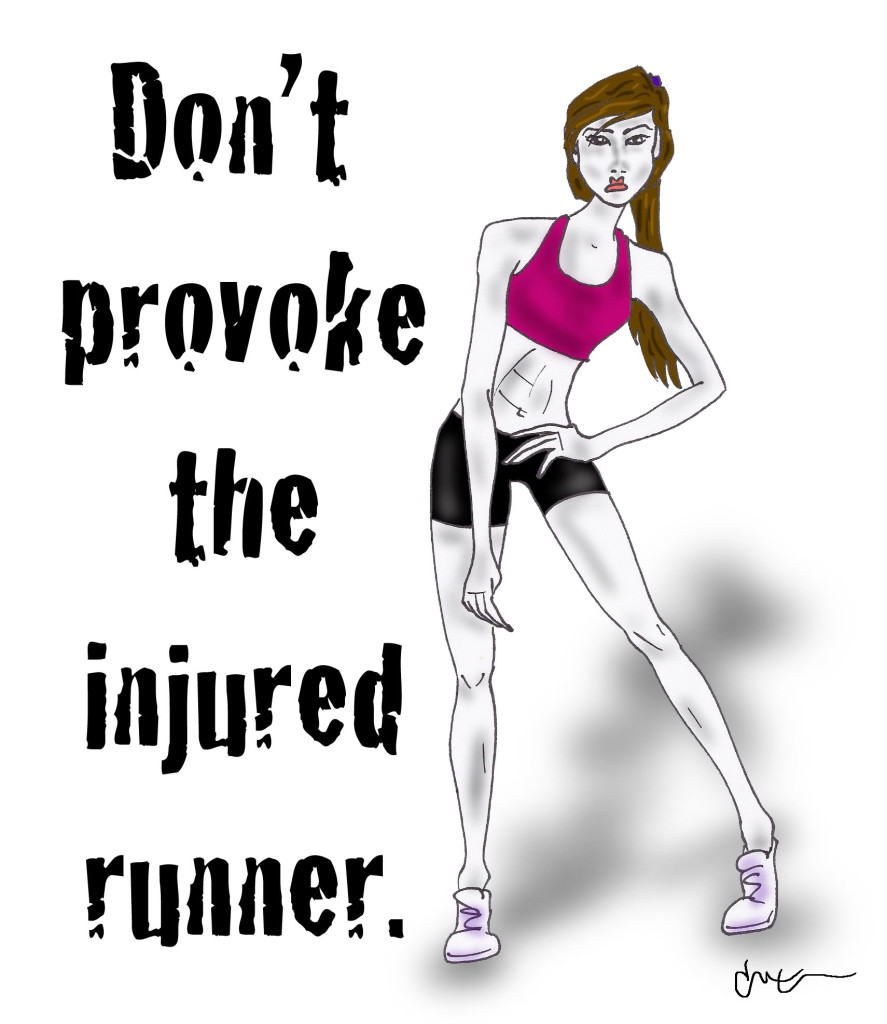
Now, the WORST and most common reasons for getting stuck in the black hole of injury cycles are…
NOT FIXING A RUNNING WEAKNESS!! Ding, ding. I’ll tell you what you’ve won…an ongoing issue that your body is continually compensating for. The muscles stuck working overtime to cover that compensating are causing your injures.
Since you never fixed the underlying issues, no amount of icing the injury or rest will keep you from getting injured again. The injury is the symptom…not the problem.
What’s My Weakness?
Hey, I’m a Weak Butt: Everyone is different, but there are FIVE top culprits for runners getting injured. Weak glutes, hamstrings, hips, back, and ankles. I wrote a post HERE highlighting each one specifically as well as exercises to help fix that issue.
I’m a Tight Runner: Tied into weak muscles are also muscles that are so inflexible they’re tugging and pulling on every other muscle. Being inflexible is setting you up for injuries, and the bad news is the older you get the harder it is to ‘undo’ that inflexible nature. It’s possible, you just have to keep working at it! The other bad news, for those who DON’T embrace stretching…the older you get the more injuries you’ll get because of it. So stretch…I wrote a whole post HERE all about my journey to becoming a pretzel person. 

I brought it up so I HAD to post it. ;)
The tricky thing with injuries is that the body is an interconnected machine…you could be struggling with a foot problem that is traced all the way to weaknesses in your hips! Crazy, huh? So it can be a bit of a Sherlock Running Holmes investigation to figure out the root of your injury, but the best places to start are the most common weaknesses, get strong there, rule them out, and see if you’re getting better. Here’s a post on my little ‘Injury from Whaaaa?” moment.
On a bit of a related note, bad form can also be an indication for where you are weak. A runner’s form breaks down as they tire, the more tired you get the more your body isn’t ‘thinking’ and slips into whatever ingrained habits it has. Usually your weaknesses will be apparent. Hey, another reason to fix those form mistakes, right?!  Read some tips on that HERE.
Read some tips on that HERE.
So we said the dreaded I-Word about a bizzillion times in this post. Thankfully running injuries aren’t like Bloody Mary or The Candy Man, we don’t conjure them up by saying their name. It’s kinda worse, because they come about while we’re doing something we love.
Stop injuries from visiting you again and again and again and again…and fix your weak spots! 
1) What’s been one injury cycle you were stuck in?
Hamstring, adductor, glute trifecta
2) How did you get out of the cycle? Or, what will you do to get out of it?
Getting my stretching on.
3) What’s been a stupid mistake, or klutzy move, you did to get injured?
Hmmm…klutz ball here, I’ve fallen a billion times.

The longer that you’re a runner the more time it takes to keep yourself healthy to run. I know I’m not the only one with a laundry list of to-do’s to keep this creaky body on this side of moving. Soon it becomes that the time you actually spend running is outpaced by the outside ‘extra’ work you do to keep you running!

Don’t make this you.
My latest article up on
Competitor: “3 Things Under 5 Minutes Every Runner Should Do Daily” explains the importance of including
these strength, flexibility, and
injury-preventative work into your day. But let’s be straight-up, lots of people have lives and getting the time to just RUN is pushing it. (I’m boring and don’t really have a life, juuust kidding…I have to work and pay ‘dem bills too, bummer. And I think I still have one or two friends rolling around this green Earth.)
But I’m betting you can find a spare 5 minutes SOMEWHERE during the day…waiting in line at Starbucks could take longer. Am I asking you to bust out some planks right there in line? If you do and take a picture of you rocking the core routine in line I’ll totally post it, so send it my way!
Injury issues aside, getting a stronger core and increasing your flexibility will translate into running faster too. Get stronger = Get more efficient = Get faster. I harp on that enough around the blog too.
The self-massage part of the injury prevention is also really important, it gets more-so the longer we run too. I may be 27 but I’m strapped in the body of a geriatric, I’ll probably be rascal-bound by 30…but I’ll take getting my miles fix up until I’m legless. I wish I could afford a professional massage therapist on my ‘staff’, but I’m not there yet and most other people are in the same boat.

In reading the article, I want to follow-up here with just HOW important it is that you know what you’re doing before you go digging around on yourself. You can make injuries worse and cause injuries if you’re not careful. Here are our self-massage rules of the road:
1) Ease into it: Just like you need your muscles warm before you stretch, make sure you’re not massaging cold muscles. Likening your pressure to stretching again, start with gentler strokes and gradually increase the amount of pressure. Your muscles will FREEZE-UP if you go in like a wrecking ball right away. [One guess what song was stuck in my head earlier.]
2) 5-10 Minutes: Limit the amount of time you spend on each area of your runner bod to only 5-10 minutes. You don’t want to go over-board.
3) Cross-Wise Passes: I have tons of hamstring issues, when I’ve got a sore spot I rub cross-wise over the area first and finish up with some flushing lengthwise passes. Don’t forget the horizontal plane, rub side-to-side and then move to the foam roller.
4) Wait 24: The most common time runners self-massage their way to worsening an injury is when they get a new soreness, freak out it’ll be an injury, then go to town massaging and stretching like a madman. This is NOT what you should do. If the pain is so bad it’s tender to the touch, wait a day to let things simmer down. Go the icing route. After that, be gentle, don’t go until you’re about to cry. Refer back to steps 1 and 2. You can self-massage yourself away from an injury if you do it right and are smart.
5) Consistency: Just like you can’t expect to PR running one day every third Tuesday, self-massage works best when you’re consistent. In fact, if you’re spooning (just kidding) spending time with your foam roller daily, you get to the point where it DOESN’T bring you near tears…miraculous, I know. 
Until we’re Lady Gaga rich, let’s self-massage ourselves, Runners, to stay healthy. Even just 5 minutes a day. Hey, triple points to the person who walks into Starbucks with their foam roller under their arm! 
1) Will you commit to doing at least 5 minutes of some core/flex/self-massage work I talked about in my article?
2) Who is consistent with their self-massage and foam rolling?
3) Did you learn some kind of nugget of wisdom from my bloggy-blabberings?

If I’m on an easy run I usually get something random stuck in my head. A phrase, a word, the same song lyric running a loop over and over until the run is over. It can sure drive a person mad when it’s of course a song you hate.
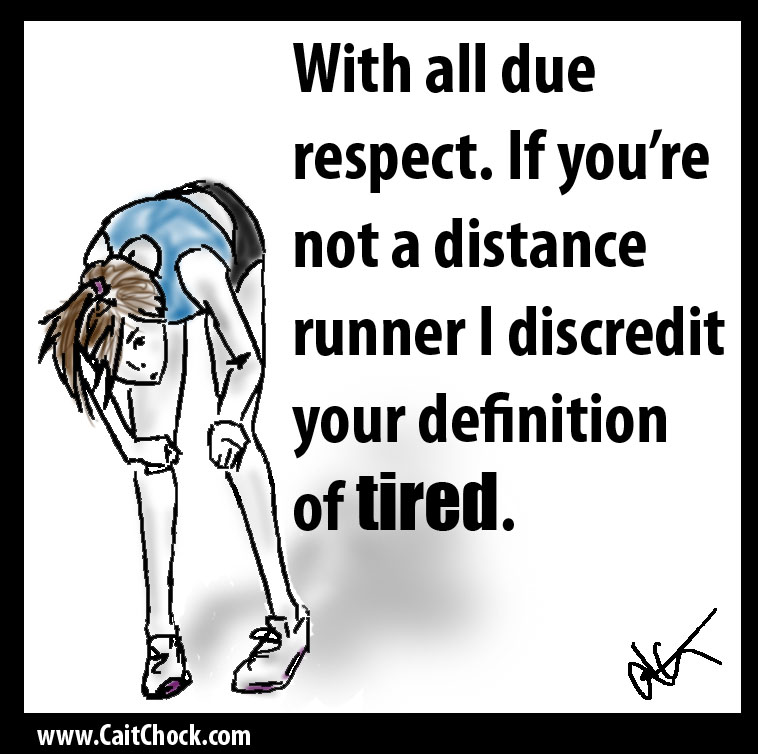
Be it as it may, I usually can’t get the lyrics to most songs right anyways, so why not make them up? It all plays in time to the music, I mean that’s all we really care about, right? 
“(S)he’s going the distance…(S)he’s going for speeeeed!” Won’t lie, Cake you have my heart and I don’t care what music comes out until the day I die this will forever by my favorite song. It’s not about racecar driving either.
“Don’t you worry, don’t you worry, Child…the track has got a plan for you.” This is a newer one and it comes on the heels of two thoughts: 1) I need to get something other than radio in my car and 2) overplaying a song leads to psychosis. True fact.
Whatever it is looping through your brain to get you through those miles is just fine and dandy. Running couldn’t get any more repetitive…haha…but that’s got to be a part of the reason we love it! Some not so hot things that come with a repetitive motion:
1) Body Adaptation:
The body is sneaky and starts to adapt, meaning if you’re running
wonky, with bad form that just get ingrained in the body’s ‘muscle memory’. Keep practicing a bad habit and over time it will bite you in the bum. Probably literally.
2) Wandering Mind: Having random thoughts through easy runs is totally fine, a nice distraction. But you don’t want to be counting blades of grass during hard repeats at the track.

How do we, as runners, combat these?
1) Muscle Memory Toolbox:
* Check your form, them start improving it. Post with a lot of info
HERE.
* Find your muscle imbalances and work on improving them. Posts
HERE and
HERE.
* Body rehab in the way of stretching and massage. Posts
HERE and
HERE.
* Drills and strength work come hand in hand with form work. Check that out
HERE.
2) Focused Mind Toolbox:
* When the pain sets in try and zone the heck out. Different from wandering mind and that’s explained HERE.
* Count your stride, breathing, and do a form-check as a means of distracting from the pain AND keeping your mind working WITH your body to get through those intervals.
* Mantras…here is where a short song lyric can help. ‘She’s going for speed’ or make-up your own positive affirmation like, ‘Smooth, strong, powerful’.
* Stay relaxed and don’t try too freaking hard. Crazy, but you can slow yourself down by just trying to force it. So stay relaxed as explained HERE.
Practicing both sets of tools during easy runs is productive, so try and cut that in between making up better lyrics to overly-played songs. Avoid psychosis…plus, don’t all runners just want to be better at, well, running? 
1) Name a tool that should be included in the muscle memory toolbox I didn’t include.
2) Name a tool that should be included in the focused mind toolbox I didn’t already name.
3) Favorite pump-up song? Or would you like to re-write some lyrics?


.jpeg?picon=3498)
By: Cait,
on 4/2/2013
Blog:
Cait's Write...
(
Login to Add to MyJacketFlap)
JacketFlap tags:
goals,
training,
exercises,
strength training,
stretching,
tips,
running,
Uncategorized,
motivation,
Add a tag
Running is wrought with the ‘two steps forward, one step backward’ tests and trials. I’d call it logic, but let’s be honest, most runners lost all logic about 5,000 miles ago. 
Progress forward is HARD fought, once you’ve been running for awhile it then come in seconds and tenths rather than minutes. Each new PR ushers you into another realm, and in order to break through and run through to that next level it takes more work than before, and the cycle continues.
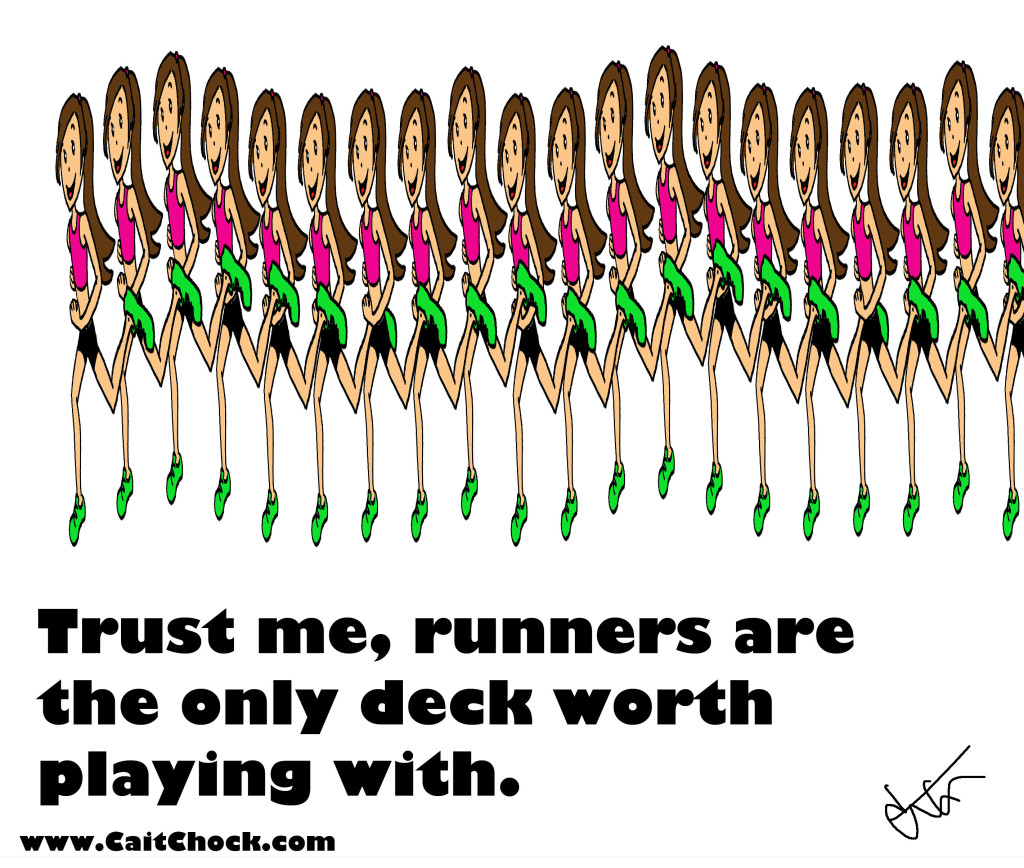
Eventually you’re working to improve by 1 or 2%, and by that time it takes more than just running harder and running faster. One must run harder and faster of course, but also SMARTER, be more ATTUNED, and then PATIENT.
All that patience sure does wear on a runner’s mindset. Typically we want those rewards, those PR’s NOW…but failing to be patient and look long term usually winds you up either 1) hurt or 2) limited.
* Hurt: By running harder and faster smartly that means allowing the body to recover between those hard and fast workouts. If you don’t recover on your easy days then you start greying the line between HARD and EASY. You might think that going harder more often will help, but in fact you wind up being too tired to really NAIL those hard workouts. A bunch of grey running just leads to a bunch of grey racing, not sharp, quality races and workouts. Well, that is if you don’t wind up injured first. I’ll include overtrained under the hurt category, because watching your times slip really does hurt too.
* Limited: By limited I mean you’re not looking at the BIG picture. To gain those ‘little’ percentages forward means you need to widen your scope beyond just running miles. It means having an actual PLAN, including core work, drills, strength work, stretching, injury prevention techniques, eating better...all those ‘extras’. Running SMARTER means being curious, and learning about all the other ways you can improve in addition to running harder and faster.
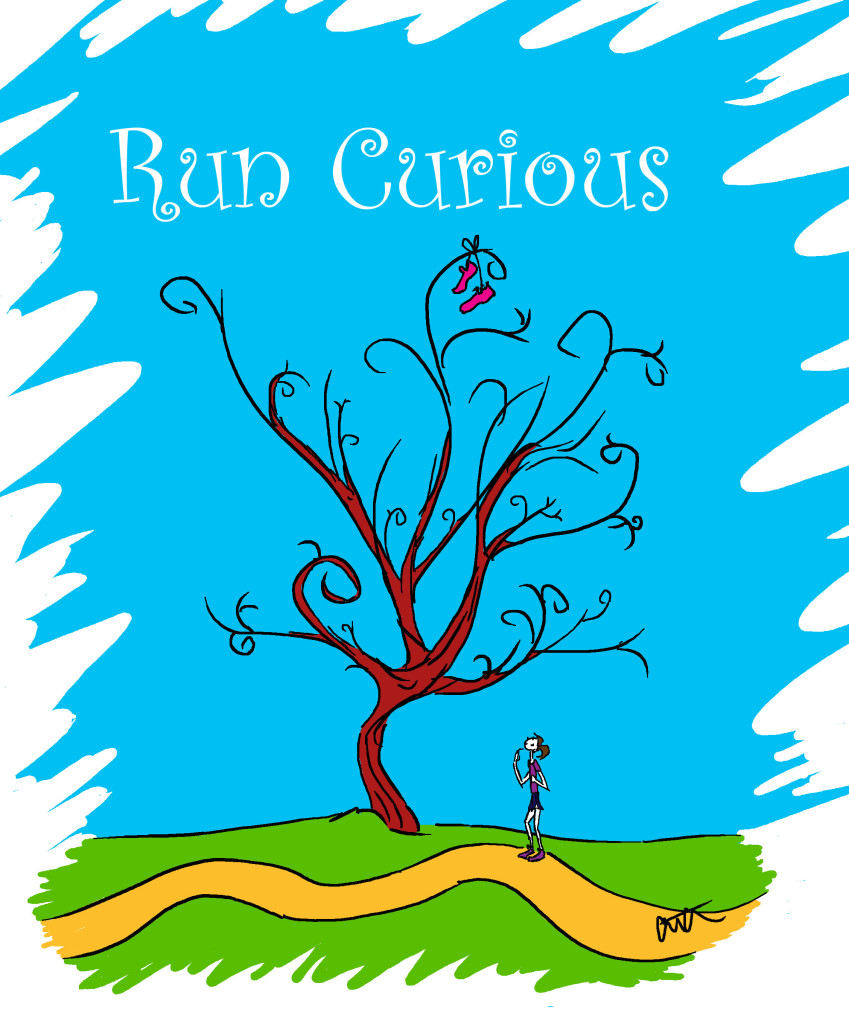
Distance Paradigm
The other thing about training is there needs to be a balance between just running MORE and running FASTER. Volume and consistency is important of course, but so is being able to get QUALITY out of those miles.
If you DO care about getting more PR’s (someone asked me, so I’ll explain that as Personal Record) then you need to have a speed component in all that running. Some runners fail to think about running more quality, and get lost in the competition to just run MORE. That’s okay, but if you want to run faster you’ve got to get used to running faster, make sense?
Looking long term and being PATIENT means you can’t have it all, all the time. Get your mileage up to a decent level, but from there focus on getting more QUALITY out of those miles. Speed workouts will hurt, duh, but it’s the kind of thing that us runners are a little crazy about and sickly enjoy. Well, enjoy after they are done.
Stepping forward and back, parallels the HARD and EASY days…let the paces step back so you can recover and then jump forward again.
Stepping forward and back also parallels this disgusting thing called an injury; they are unavoidable to even the most patient runner. Take them in stride, get through them and be prepared to step forward again.
Running steps forward every time you get a new PR or hit better times in your workouts; on the heels will be the times when you take steps back with bad races, off days, and horrendous blow-ups of workouts. They happen…don’t let them derail you…because if you are running SMARTLY you can’t ‘lose’ your fitness after just a bad race, dispute that mental thought, it’s a lie.
Runners often want those gains NOW. But sadly, those gains have to be earned…earned with hard freaking work and loads of patience.
1) Fill in the blanks: I recently took a step forward _________________ and was prepared to take a step backwards __________________________.
2) Fill in the blank: I really want to run faster NOW, but looking long term I recently incorporated __________________ to get faster, the payoffs may take a little time.
3) When an injury DOES crop up it tests my patience but I get through it and grow as a runner by ___________________________.


 I’ve been posting a lot about how to re-claim your creativity and account for your creative time. The following exercises are a great way for you to really dig in and be honest with yourself. What are your priorities? How does your use of time reflect those priorities?
I’ve been posting a lot about how to re-claim your creativity and account for your creative time. The following exercises are a great way for you to really dig in and be honest with yourself. What are your priorities? How does your use of time reflect those priorities?
Exercise #1: Your Priorities and Your Time
Step One: List the first five things you spend your time on. Don’t censor just write it down quickly (i.e. surfing the internet, sleeping, etc.)
1.
2.
3.
4.
5.
Step Two: Write down the five most important things in your life (i.e. family, health, writing, etc.).
1.
2.
3.
4.
5.
Step Three: Now compare and contrast your lists. What is important to you and how are you really spending your time? This will be very illuminating.
 Exercise #2: Account for How You Spend Your Time
Exercise #2: Account for How You Spend Your Time
For a whole week, carefully account for your time. Use a timer that goes off every 30 minutes. Write down what you’ve done for those 30 minutes. Do it every 30 min, for every day, for one week. See what you really do with your time! Now compare that with your priorities from exercise #1. Make the adjustments you need to create time for creativity in your life!
These exercises were shared by author Laurie Halse Anderson at the 2011 LA SCBWI Conference. Be sure to check out these other notes from her talks:
- Nine Tips for Finding and Re-Claiming Your Time and Creativity
- Three Writing Myths that Hurt Us
- Attitudes to Grow Into Your Soul
Laurie Halse Anderson is the New York Times-bestselling author who writes for kids of all ages. Known for tackling tough subjects with humor and sensitivity, her work has earned numerous ALA and state awards. Two of her books, Speak and Chains, were National Book Award Finalists. Mother of four and wife of one, Laurie lives in Northern New York, where she likes to watch the snowfall as she writes.






 0 Comments on Account For Your Time! as of 1/1/1900
0 Comments on Account For Your Time! as of 1/1/1900





















